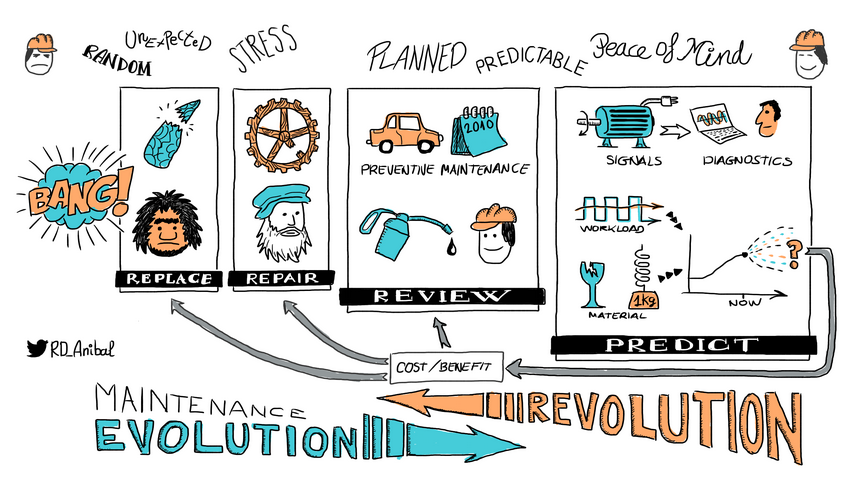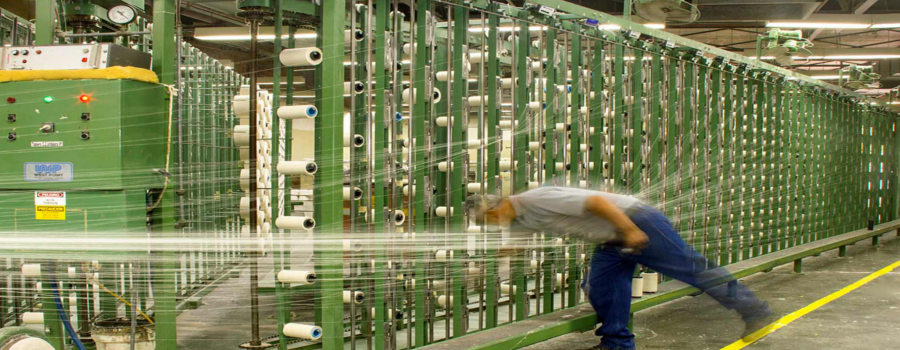In previous posts, predictive maintenance was mentioned as one of the main digital enablers of Industry 4.0. Maintenance, linked to the industrial revolution, however, has accompanied us in our evolution as human beings.
Since prehistory, our ancestors have built tools that suffered wear and sometimes broke without prior notice. The solution was simple: to carve a new tool. By creating more elaborate mechanisms (e.g. wooden wheel), the natural alternative to disposal became the reparation by the craftsman. Mechanical looms of the First Industrial Revolution were even more complicated of repairing so specific professions emerged as precursors of current maintenance workers. During this evolution, the wear and breakdown of mechanical parts without prior notice continued as part of everyday factories.
Why this gear has broken? yesterday worked perfectly. Human brain can handle concepts such as linearity of events (seasons, day and night,…) or events that happen more or less at regular intervals. However, these unforeseen drove operators crazy. How can we ensure that gear does not break again? The answer was biologically predictable: “… let’s stop the machine every 2 days (for example) and let’s review gear wear…”

This tradition has resulted in the everyday maintenance routine that is applied in industry and in consumer products such as our cars. Our authorized dealer obliges us to make periodic reviews (e.g. each 10,000 km) to check critical elements (brakes, timing belt, …) and change pieces more prone to wear (tires, filters …). This is called preventive maintenance, and is applied in factories and other facilities (e.g. wind turbines) to avoid unexpected breakdowns. However, these faults cannot be eliminated (precisely, they are unforeseen) the only possible reaction is to repair them. This is called corrective maintenance and everyone hates it.
How to stop to all this flood of unexpected breakdowns, repair costs and unnecessary revisions? One of the disciplines with more experience since CARTIF‘s creation is predictive maintenance that seeks to mitigate (it would be unrealistic to assume that we will remove the unexpected) unexpected breakdowns and reduce machines’ periodic reviews. Again, predictive maintenance can be explained as a obvious biological response to the problem of unexpected breakdowns. It is based on the periodic review using characteristic signals of machine’s environment that may anticipate a malfunction. The advantage of this maintenance is that it doesn’t require stopping the machine like with preventive maintenance. For example, an electric motor can have a normal power consumption when it’s correctly operating, but this consumption may increase if some motor’s component suffers from some excessive wear. Thus, a proper monitoring of the consumption can help detecting incipient faults.

Continuing with the electric motor example, what should be the minimum variation of consumption to decide that we must stop the motor and a repair it? Like many decisions in life, you need to apply a criterion of cost/benefit, comparing how much can we lose if we do not repair this motor versus how much money the repair will cost. How to reduce uncertainty in this decision? The answer is a reliable prediction of the fault’s evolution.
This prediction will be influenced by many factors, some of them unknown (like we said it’s something random). However, the two main factors to consider for the prediction are (1) the kind of evolution of the damage (e.g. evolution of damage in a fragile part will be very different from a more or less tough or elastic piece) and (2) workload that the machine will suffer (a fan working 24/7, compared to an elevator motor that starts and stops every time a neighbor presses the button on a floor). A reliable prediction allows the maintenance manager choosing from, together with the forecast of factory workload, the more beneficial option, which in many cases is usually planning maintenance work without affecting production schedule.
Another beneficial effect of predictive maintenance is that a proper analysis of the measured signals provides evidence of what element is failing. This is called fault diagnosis and helps to reduce uncertainty in the more appropriate maintenance action. An example is the vibration measurement that helps distinguishing a fault of an electric motor having an excess of vibration because of an incipient short-circuit or due to a damaged bearing. But that’s the subject of another post.
- Behind the Curtain: Explainable Artificial Intelligence - 12 July 2024
- Digital Twin: Industry 4.0 in its digitised form - 9 October 2023
- Artificial Intelligence, an intelligence that needs non-artificial data - 16 December 2022

